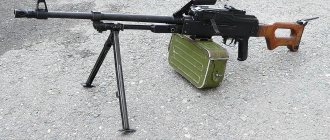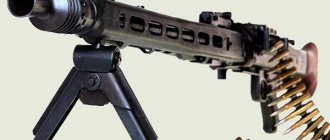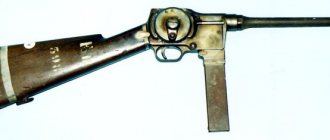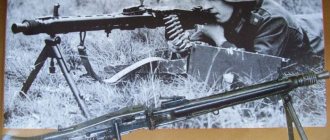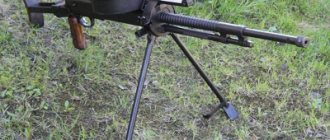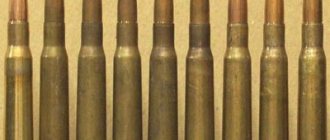DS-39 machine gun DS-39 - a heavy machine gun of the USSR during the Second World War.
The DS-39 weapon appeared as a need for its own light and maneuverable heavy machine gun during and after the First World War to replace the legendary Maxim machine gun. Initially, it was planned to adopt the German Dreyse system, but due to the fact that an excellent light machine gun of the Degtyarev system appeared, the reference point fell on it.
History of creation
The task of designing an easel light machine gun was set by the headquarters of the Red Army on July 13, 1928. In this way, the idea of unifying machine gun weapons should have been resolved.
V.A. Degtyarev began creating an easel machine gun and by the end of 1930 a prototype was manufactured. Subsequently, a lot of shortcomings were revealed in the machine gun, the requirements for the weapon also changed, and therefore it was modified many times (for example, in 1933 - an adaptation for a fabric tape from Maxim and later - for a loose tape from Maxim-Vickers).
DS-39 machine gun
After a huge number of changes and modifications, the DS-39, of course, retained a number of common features with the light machine gun, but was already less unified.
Specifications
In order for the reader to have a better idea of this weapon, it is worth giving the characteristics of the DS-39 machine gun.
It was developed for the 7.62 x 54 mm cartridge, standard for its time - the same as that used in the Maxim machine gun and the Mosin rifle. Very powerful, it has proven itself well almost half a century ago.
The machine gun itself weighs 14.3 kilograms. But with the machine and the shield, the weight reached 42.4 kilograms - quite a lot. The machine weighed 11 kilograms, and the shield - 7.7. To this should be added a cartridge box weighing 9.4 kilograms. By the way, during development, Degtyarev abandoned the standard tripod machine designed by Kolesnikov, developing a lightweight analogue instead. The shield provided better protection for the machine gunner. It had only a small sighting slot, and was also equipped with a special bracket that allowed the installation of an optical sight.
Together with the machine gun, the length of the machine gun was 1440 millimeters, while the machine gun itself had a length of 1170 millimeters.
Design and operating principle
The automatic operation of the machine gun is based on the removal of powder gases into the chamber. The gas chamber has a pipe and is located below, in the middle part of the barrel and is equipped with a regulator for the amount of exhaust gases. The gas piston has a long stroke. The barrel bore is locked using two identical lugs, namely: when the striker of the bolt frame moved forward, it moved them apart, and when moving back, the lugs were brought back by the bevels of the frame.
Design of DS-39
The machine gun is equipped with a replaceable barrel, which has transverse ribbing, a conical flame arrester and a folding handle to facilitate barrel change and transportation. A characteristic unique feature of the DS-39 is that it has two rates of fire: against air targets - 1200 rounds per minute, against ground targets - 600 rounds per minute. This functionality was provided by a spring buffer located in the butt plate and turned on at large angles of inclination.
The return mainspring of the machine gun is located at the bottom left, in the receiver tube. The charging handle is located on the right side.
Design of DS-39
Sights are a folding frame sight for light and heavy bullets.
The machine gun has huge problems with the ammunition supply system - feeding from a metal or fabric belt by a slider-type mechanism at the moment of the moving system back. Due to the enormous accelerations and extremely complex trajectory of movement, cartridges quite often flew out or became deformed. To avoid this, cartridges with a steel or bimetallic sleeve were used; brass sleeves were prohibited.
Design of DS-39
Despite such shortcomings, in view of the imminent possible entry into the Second World War of the Soviet Union against the powerful rivals of Germany in the West and Japan in the East, who paid the lion's share of attention to equipping troops with automatic weapons, on September 22, 1939, the 7.62 mm 7.62 mm was adopted by the Red Army heavy machine gun under the symbol DS-39. But the machine gun had to be equipped with a Degtyarev tripod folding machine instead of the Maxim and Kolesnikov universal machines. This “tripod” had a mechanism for rough and fine vertical aiming and a bracket for an optical sight. It was also possible to install an armored shield with a window for installing optics. The anti-aircraft version of the machine gun had a special machine. The tank version remained at the prototype level.
Heavy machine gun DS-39 (Degtyarev Heavy machine gun model 39)
The need for a maneuverable and lightweight heavy machine gun was recognized already in the First World War and the Civil War. Since there was no proprietary light machine gun system, they wanted to adopt the German Dreyse system, using military-technical ties with Weimar Germany for this purpose. However, the appearance of a successful light machine gun of the Degtyarev system forced a reorientation towards it. The Red Army headquarters issued an order to design a light heavy machine gun on July 13, 1928. The idea of unifying machine gun armament had by this time taken hold, and in the Degtyarev family of machine guns, heavy-caliber and heavy (DS) machine guns were to be added to the infantry, aviation and tank ones.
The first heavy machine gun based on the Degtyarev Infantry on Kolesnikov’s universal machine gun was presented by the designer at the beginning of the 30th year. Subsequently, the machine gun was repeatedly modified as requirements changed and its shortcomings were identified. So, for example, in 1933, the machine gun was adapted to use a fabric belt from Maxim, and later to use loose tape of the Maxim-Vickers type.
In addition to V.A. Degyatrev, S.M. participated in the development of the machine gun. Krekin, P.E. Ivanov, A.I. Kuznetsov (master), and N.D. Zernyshkin (mechanic mechanic).
After numerous modifications, Degyatrev's heavy machine gun became less unified with the light machine gun, but retained a number of common features. The automatic machine gun operated by diverting powder gases into the gas chamber. The camera was located in the middle part (bottom) of the barrel. The gas piston had a long stroke. The gas chamber had a pipe. The gas chamber regulator limited the amount of gases released. The shot was fired from the rear sear. Two symmetrical lugs locked the barrel bore - moving forward, the striker of the bolt frame spread the lugs to the sides; when moving backwards, the lugs were brought together by the bevels of the frame. The original feature of the machine gun was its double rate of fire - against ground targets it reached 600 rounds per minute, against air targets 1200 rounds per minute. To increase the tempo, a spring buffer mounted in the butt plate was used. The buffer was turned on at high elevation angles.
The machine gun's replaceable barrel was equipped with a conical flame arrester and transverse fins. A folding handle on the barrel was used to carry the machine gun and make it easier to change the barrel.
The machine gun was equipped with a folding frame sight with scales for heavy and light bullets. The controls were a trigger lever and two buttplate handles, made like a Maxim machine gun. Since these controls were installed, the recoil spring (which on prototypes was located in the buttplate tube) was moved to the receiver tube located below on the left side. On the right side was the charging handle.
The biggest problems were created by the feeding mechanism. The tape was fed by a slider-type mechanism while the moving system was moving backwards. The cartridge was removed from the tape by a spring bolt extractor, and the reducer lowered the cartridge into the hard legs of the bolt with the rim. The same paws were used to remove the spent cartridge case from the chamber, which was reflected downward by the next cartridge. The complex trajectory with a high rate of fire required high accelerations, which caused frequent deformation or dismantling of the cartridge. Therefore, only cartridges with a bimetallic or steel sleeve were used; in the DS-39 the use of cartridges with a brass sleeve was prohibited.
On September 22, 1939, the “7.62-mm heavy machine gun of the 1939 model of the Degtyarev system,” designated DS-39, was put into service. The food had to be supplied from a metal or fabric belt (in 1939, the Kovrov designer Rakov created a machine for equipping belts). Kolesnikova and Maxim refused to use universal machines. Instead, Degtyarev's tripod folding machine was adopted for service, which allowed firing only at ground targets. The machine was equipped with tubular legs adjustable for the angle of rotation with folding additional and rigid main openers, an arc mechanism for vertical coarse aiming and a screw - fine aiming, bracket for an optical sight. Shooting was carried out from kneeling or prone positions. An armored shield with a window for using an optical sight could be installed on the machine. There was a special machine for anti-aircraft shooting. To transport the machine gun on a pack saddle, a set of VSD-39 packs was used. The tank version did not advance beyond the prototype.
The haste to adopt the machine gun, as well as other types of weapons and military equipment, can be understood - the Soviet Union could soon enter World War II. Japan, which was the main enemy in the east, and Germany, which was the main potential enemy in the west, even despite the signed treaties, paid serious attention to equipping their armed forces with automatic weapons. In addition, after the occupation of Czechoslovakia, Germany increased the supply of machine guns to its troops and acquired a developed arms industry.
The SVT rifle and the Degtyarev heavy machine gun were an important part of the rearmament program of the Soviet army. The production of DS and machine tools for them in Kovrov at plant No. 2 was mastered already in 1939; at the Tula Arms Plant, serial production was mastered in June 1940. The production of DS required great precision. However, out of 10,677 such machine guns produced in 1940, they amounted to 6,628 or 62%.
The reliability of the machine gun was insufficient. It was not possible to overcome a gap in the cartridge receiver, a heavy bullet falling out of the cartridge case, ruptures of the cartridge cases (due to the high speed of movement with a large length of the locking unit and the absence of preliminary displacement of the cartridge case), the low survivability of some parts, and unsatisfactory performance at low temperatures and dust. Designer Simonin's proposals (new lid stopper, barrel radiator and flag contactor), implemented in 1941 in an experimental machine gun, did not correct the main shortcomings.
Production of the DS was discontinued in June 1941, just a month after Nazi Germany attacked the USSR, production of Maxim machine guns was resumed. For the entire 1941, 9691 Maxim machine guns and 3717 DS machine guns were produced (about 28%). In total, 10,345 DS-39s were produced, most of which were lost in the first months of the Second World War (some of them were found among the partisans).
The “unfortunate machine-gun drama” (as it is sometimes called by analogy with the “unhappy gun drama” of the 1860s) was caused not so much by the constructive as by the technological inadequacy of the new system. But there was no time for fine-tuning (although the possibility of successful fine-tuning was proven by the development of an experimental DS-43 machine gun based on the DS-39). The complex system did not provide the opportunity to quickly expand production. The need to urgently form units from reservists who were not familiar with the new systems made it quite logical to return to the machine gun that had long been mastered by the troops and industry.
Pinsk partisans on the march. The partisan in the foreground carries a 7.62-mm heavy machine gun DS-39 (Degtyarev heavy machine gun model 1939), the crew of such a machine gun consisted of four people. Pinsk partisans operated at the junction of the Minsk, Polesie, Baranovichi, Brest, Rivne and Volyn regions of the Belarusian SSR
Technical characteristics of the DS-39 machine gun: Cartridge – 7.62 mm model 1908 (7.62x54R); The weight of the machine gun “body” is 14.3 kg; Machine gun weight - 42.4 kg (on a machine with a shield); The length of the machine gun “body” is 1170 mm; The total length of the machine gun is 1440 mm (on the machine); Barrel length – 723 mm; Rifling – 4 right-hand; Rifling stroke length – 240 mm; The initial speed of a light bullet is 860 m/s; Sighting range when using a light bullet – 2400 m; Sighting range when using a heavy bullet – 3000 m; Rate of fire – 600/1200 rounds per minute; Combat rate of fire – up to 310 rounds per minute; Food - canvas belt for 250 rounds or metal belt for 50 rounds; Weight of the cartridge box - 9.4 kg (with a belt for 250 rounds); Type of machine – infantry tripod system Degtyarev; Shield weight – 7.7 kg; Machine weight – 11 kg.
Based on materials from the article by Semyon Fedoseev “Machine guns of the Second World War”
Production and reliability of the machine gun
Serial production of this weapon was launched already in 1939 at the Kovrov Plant No. 2, and at the Tula Armory in June 1940. But already in June 1941, after Germany’s attack on the USSR, production of the DS-39 was stopped and production of the old, industry- and time-tested Maxim machine guns continued. A total of 10,345 units of this weapon were produced, most of which were lost in the first months of the war.
Soviet machine gunners and DS-39
There were several main reasons for refusing further production, namely: low quality of some parts; low survivability when exposed to low temperatures and dust; frequent ruptures in the cartridge receiver; a heavy bullet falling out of the cartridge case or the cartridge being crushed. Of course, there are known attempts to modernize the machine gun by designer Simonin (the development of a new locking pin, lid stopper, barrel radiator), but the main shortcomings were never overcome.
Soviet machine gunners and DS-39
The machine gun was used in the initial stages of the Second World War by the Red Army until all copies were destroyed. The DS-39 was also used by the troops of the Third Reich in the occupied territory of the USSR. Approximately two hundred captured machine guns were in service with the Finnish army.
Captured DS-39 from German soldiers
Important advantages
When describing the DS-39, one cannot fail to mention some important advantages that the machine gun had.
Of course, one of the main ones has already been mentioned above - high power and serious combat distance. Moreover, it was no longer water-cooled, like the Maxim machine gun, but more modern - air-cooled. This significantly reduced weight and increased mobility. It was the outdated “Maxim” that was the main competitor of the Degtyarev machine gun, so further comparisons will be made with it.
Relatively simple reloading increased the practical rate of fire. Simple and convenient aiming increased the ability to hit the target even for not the most experienced shooters. To achieve such results when using the Maxim machine gun, it was necessary to train the machine gunner for a long time.
Light weight was also a plus. For comparison: only 42 kilograms versus 64 kilograms for the Maxim.
The machine had a special design that made it possible to shoot from the knee or while lying down. This turned out to be very convenient in setting up a safe and convenient firing position.
In general, the design resembled the DP-27 light machine gun, which was well known among the troops. Of course, such similarity could also be considered an advantage, since it made it possible to simplify the process of becoming familiar with a new weapon.
Characteristics
| Weight | without machine: 14.3 kg with machine: 33 kg |
| Length | 1170 mm |
| Barrel length | 720 mm |
| Cartridge | 7.62×54 mm R |
| Caliber | 7.62 mm |
| Rate of fire | combat: 300-310 rounds/min, rate of fire: 600-1200 rounds/min |
| Initial bullet | 800 m/s |
| Sighting range | valid: ~1000 m maximum sighting:
|
| Type of ammunition | belt for 250 rounds in a metal box, box weight 9.88 kg |
| Sights | frame |
Combat range
As mentioned above, the DS-39 heavy machine gun used 7.62 x 54 mm cartridges. Together with the long barrel, this provided a serious sighting range and high penetrating power.
The initial speed of the bullet was 860 meters per second. When using a light bullet, the machine gun made it possible to hit the enemy at a distance of up to 2.4 kilometers. If a bimetallic heavy bullet was used, this distance increased to 3 kilometers. So the aiming range of the DS-39 turned out to be excellent - not all heavy machine guns of that time could boast of such impressive characteristics.
It is important that the combat rate of fire turned out to be quite high - more than 300 rounds per minute.
Feeding was carried out using a metal belt with 50 rounds or a canvas belt with 250 rounds. The metal belt turned out to be heavier and less spacious. But when using it, the risk of uneven feeding of the cartridge and, as a consequence, delays during shooting was sharply reduced. And when using canvas, this happened quite often, if only one machine gunner had to shoot without a second number to feed the tape.
Two fire modes
When developing the DS-39, designer Degtyarev provided for the possibility of firing not only at ground targets, but also at air targets. Yes, yes, this machine gun could well be used to destroy low-flying enemy aircraft. There was even a special shooting mode designed for this.
The weapon had two modes - 600 rounds per minute and 1200. The high rate of fire significantly increased the ability to destroy a fast-moving target. To increase the rate of fire, a special spring buffer was used, installed in the butt plate.
The transition from one mode to another was very easy and quick - just turn the handle of the buffer device located on the bottom of the receiver.
Replaceable barrel
A barrel overheated from long-term shooting is a serious problem with any machine guns, from the Maxims of the late 19th century to the most modern analogues.
It didn’t bypass the DS-39 either. After 500 shots, the barrel overheated greatly, which led to expansion and a sharp decrease in the force of the shot - the bullet simply fell out of the barrel, flying at best several tens of meters. Waiting for the barrel to cool down is simply impossible in combat conditions. Therefore, the designer provided the possibility of quickly changing the barrel. It was equipped with a special wooden handle to avoid burns. Moreover, it took an experienced machine gunner only half a minute to replace the barrel! Of course, this provided much greater firepower than using a single barrel. While the second barrel was heating up, the first one had already cooled down and could be reinstalled.
The further fate of the weapon
As mentioned above, the weapon went into production unfinished, with many shortcomings that had not been fully eliminated. In the first years of the war, there was no opportunity to refine it and put it into production for obvious reasons.
However, in 1943, the issue of DS-39 was returned to again. Moreover, this direction was personally supervised by I.V. Stalin, who was well aware of the importance of having high-quality and reliable heavy machine guns in the troops.
A special commission was assembled to re-examine the machine gun's potential. However, the commission's decision was quite unexpected. After all, besides the DS-39, she also considered other options. One of them was a machine gun made by an unknown designer named Goryunov. To everyone’s surprise, it turned out that his machine gun was superior to its counterpart from a venerable colleague in almost everything: reliability of design, survivability of parts, reliability.
During a personal meeting with Degtyarev, Stalin asked him what he himself thought about this. Vasily Alekseevich, without hesitation, stated that Goryunov’s machine gun would increase the combat effectiveness of the army, which means preference should be given to it.
Thus ended the short and not very successful career of the DS-39.
Where was the machine gun made?
The first samples of the machine gun rolled off the assembly line in Kovrov. However, the manufacturer of the DS-39 subsequently changed. Already in 1940, production was moved to Tula.
Unfortunately, the sudden outbreak of war led to the fact that some of the production facilities were captured and others were destroyed. And only a part was saved, evacuated and collected in a new place. But the production of a heavy machine gun is complex, so in order to supply the army with powerful defensive weapons, it was decided to return to the production of Maxim machine guns; fortunately, the equipment was not destroyed, but mothballed. As a result, during the war years, many of these heavy, massive, but powerful and reliable machine guns came off the production lines, which more than once made it possible to hold positions even under the most furious pressure of the enemy.
Used by
Of course, the main user of the machine gun was the USSR. However, over time, 10 thousand machine guns sent to units were lost during the fighting or became faulty. They stayed in partisan units for quite a long time.
But during the fierce battles of 1941, Finland captured about 200 machine guns, which were put into service and used until the very end of the war. There is information that about 145 machine guns were stored in mobilization warehouses after World War II until 1986, when they were finally written off.
Finally, many captured machine guns fell into the hands of Wehrmacht soldiers. Here they were called MG 218. True, they were not used on the front line, but mainly by security and police units in the occupied territories.
Main disadvantages
Alas, despite its important advantages, the Degtyarev machine gun also had many serious disadvantages. One of them was insufficient reliability. Even after many years of improvements it was not possible to completely get rid of them.
The rather complex cartridge feeding system turned out to be not very successful - the cartridges or empty cartridge case were often deformed, which is why it was necessary to stop firing to fix the damage. Of course, during a battle this would be an excessive luxury - the enemy would not give the machine gunner a few minutes to calmly work on getting the weapon ready. True, the problem was solved by the use of steel cartridges on cartridges for the DS-39 machine gun. But the army predominantly used softer brass cartridges. This was a serious blow to the popularity of the machine gun.
When using a heavy bullet, the cartridge often simply disintegrated - the strong recoil caused subsequent cartridges to disintegrate. This also led to the need to disassemble the machine gun.
Negative reviews often came from the troops, caused by the inability to use the weapon at low temperatures or in highly dusty conditions - the machine gun simply jammed.
That is why, despite the numerous advantages of the new weapon, it never gained much popularity, failing to become the only heavy machine gun of the Red Army.


